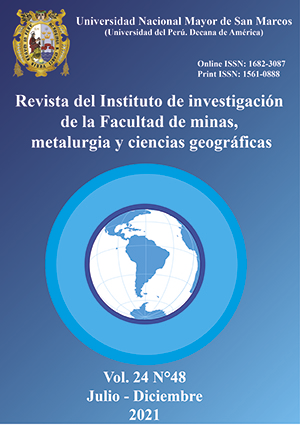Compressive strength of concrete with the addition of recycled expanded and extruded polystyrene
DOI:
https://doi.org/10.15381/iigeo.v24i48.20725Keywords:
recycled extruded polystyrene, recycled expanded polystyrene, environmental pollution, concrete made with solid wasteAbstract
The objective of this research was to evaluate the compressive strength of the 350 kg / cm2 design concrete manufactured in the city of Huancayo, using coarse and fine aggregates with recycled extruded polystyrene (XPS) materials, washed and unwashed, duly scratched unwashed expanded polystyrene (EPS) in pearl shape. Samples of polystyrene waste were taken in recreational and public service facilities and aggregates from quarries near the city of Huancayo that were subjected to quality control tests according to the Peruvian technical standard NTP 400.037. Different mixtures consisting of recycled polystyrenes and aggregates were made for the manufacture of concrete, the compressive strength was analyzed in a specialized laboratory. The results showed that the concrete mix made with recycled and washed XPS, whose proportion was 30% coarse aggregate per XPS and 20% fine aggregate per XPS, at the age of 28 days, exceeded the design resistance of 350 kg / cm2, obtaining a value of 365 kg / cm2 being approximately 74% with respect to the resistance to compression of the standard mixture sample without recycled materials, whose value is 495 kg / cm2.
Downloads
Published
Issue
Section
License
Copyright (c) 2021 Janet Andía Arias, Raymundo Erazo Erazo

This work is licensed under a Creative Commons Attribution 4.0 International License.
AUTHORS RETAIN THEIR RIGHTS:
a. Authors retain their trade mark rights and patent, and also on any process or procedure described in the article.
b. Authors retain their right to share, copy, distribute, perform and publicly communicate their article (eg, to place their article in an institutional repository or publish it in a book), with an acknowledgment of its initial publication in the Rev. Inst. investig. Fac. minas metal cienc. geogr.
c. Authors retain theirs right to make a subsequent publication of their work, to use the article or any part thereof (eg a compilation of his papers, lecture notes, thesis, or a book), always indicating the source of publication (the originator of the work, journal, volume, number and date).























